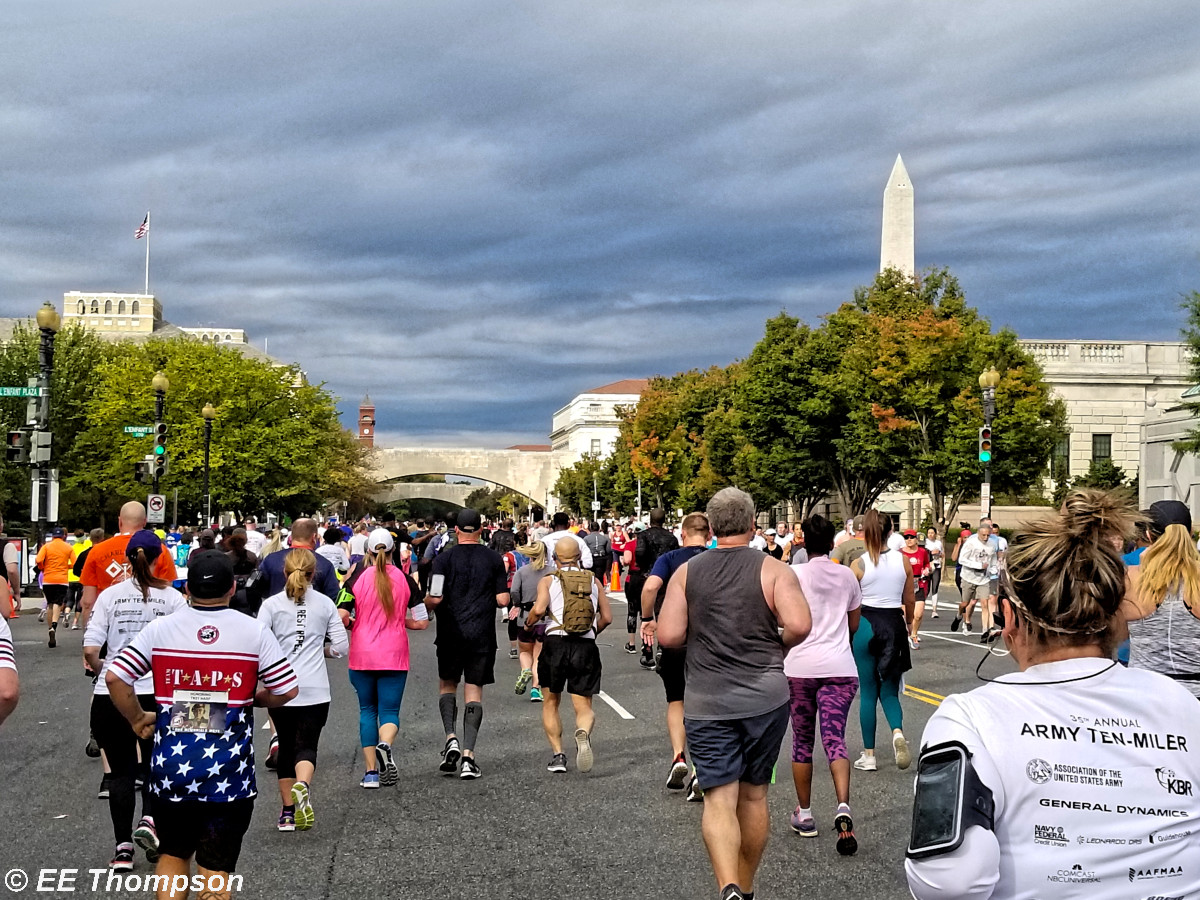I often listen to audio books or podcasts as I run. Lately I’ve been listening to Living Everyday Zen by Charlotte Joko Beck. The audiobook is a compilation of her dharma talks on many aspects of Zen practice. To my way of thinking, Beck is a hard-nosed teacher. She teaches incremental practice and largely avoids talking about moments of kensho or enlightenment. Her description of mindfulness is especially interesting to me because it’s physical instead of mental. She says practice is to label thoughts and try to feel the underlying bodily sensations that gave rise to them. I’m used to noticing when my mind has derailed and returning it to the present, but not to seeking for how I feel underneath.
As I ran today I was listening to her answer students about dealing with difficult or painful times in life. Beck teaches that the aim of practice is to fully experience life at all times. The goal is to be free of both grasping at good experiences and avoiding bad ones. One student asked if practice could make a painful time end sooner. She gently chided, “how could you ever do that?” She went on to say that as awareness expands, the pain stops becoming the focus. The rest of the rich tapestry of life is also present and the pain falls into context. As I listened, I realized that what she was saying paralleled the process of how I became a distance runner. For me, running evolved into practicing Zen.
Why running?
Most of my life I’ve danced for exercise. Unfortunately, a while back I had a falling out with a spectacularly narcissistic dance teacher. I didn’t find another dance group that suited me so I shifted my attention to music and visual arts. Between my desk job and sedentary hobbies, I wasn’t getting enough exercise. I ended up overweight and out of shape. In spring of 2017 decided it was time to reverse the damage I was doing to my body, but what to do? I settled on the path of least resistance, body weight strength exercises and running.
I’ve never liked running though. Gym teachers had pushed me to run too far and fast, both in high school and later in Tang Soo Do. Since I didn’t like runnig I started out getting in shape on an exercise bike. I hated it though. The local gym was crowded, I didn’t like getting home from work late, and sitting on the bike was mind-numbingly boring
C25K
I finally decided to just put on sneakers and head out the door. The cool March air was much nicer than the gym so I did a little research and found Couch to 5K (C25K). It’s a beginning running program developed by Josh Clark in the ’90s It claimed to be able to get even the most dedicated couch potato in shape to run a 5K in a mere 9 weeks. That sounded a bit optimistic but the app was free so I had nothing to lose. I set a goal race to do an untimed 5K sunset “glow run” at the end of September and started into the program.
As I worked thorough C25K a weird thing happened. I went from tolerating walk/run days to looking forward to them. Sometimes I found myself looking longingly at my shoes on rest days. I had never enjoyed solo exercise before. As summer passed, I was able to stick to the program despite the various aches and pains of running. For the first time in my life I learned to pace myself, starting with 5 minute stretches and working up to the full 1/2 hour of C25K. I learned to jog incrementally slowly uphill and relax into down hill stretches. I learned to ease stitches and to recognize the signs before I even got a cramp. I found running clothes I liked and starting watching the weather. I became a runner.
Running the Race
The problem was C25K is a half-hour program but I couldn’t run 5K in a half hour. I was a beginner in my late 40s and running a pretty typical 12-13 minute mile. That meant I had to get from running 30 minutes to close to 40 minutes. Unfortunately that was harder than I expected. I tended to get out of breath no matter how slowly I jogged and my knees bothered me endlessly. I toyed with Galloway’s run-walk-run and managed the 5K distance but it was oddly unsatisfying. The constant dings from the timer in my earbuds distracted me and never seemed to mesh with my rhythm. I didn’t feel as good after the exercise either.
I talked to a friend who was into fitness about my mental 1/2 hour wall. She suggested I choose a route that ended with a downhill stretch to push a bit farther. That was helpful and after a few runs of pushing myself downhill at the end, I finally managed the full 5K distance. It was hard and I ended breathless but I was ready for the race. The race day was a hot, muggy September evening and I disappointed myself by needing to take walking breaks. The course seemed endless, much longer than my familiar neighborhood route. I finally crossed the finish line, gratefully accepting a bottle of cold water and my first race completion medal.
I enjoyed it enough that I signed up for a 5K cross-country race with a local running club a couple weeks later. Again, I slogged through, fighting asthma in the freshly mown grass. I kept getting out of breath and had to walk hills. I was pleased to have managed another 5K but I thought it was my distance limit.
Finding my Zen
People who write about running speak of a “conversational pace.” That hot summer I thought the concept was laughable. By the end of even a slow 5K my heart was pounding and I was always out of breath. As the weather cooled down though, suddenly a surprising thing happened. One crisp October afternoon I realized I was over a mile into my run and not breathing hard. The phone rang on my earbuds and I was able to take the call. Magic! I had a conversational pace. Runners reading this article will notice that with a goal race in September, I had unwittingly been pushing distance in August. It was quite a rookie mistake.
Even though I wasn’t breathless any more, I was still pretty uncomfortable at the end of my 3 mile workouts. All my life as a dancer I accepted that I would have to recondition after a break in dance classes. At a certain point, I always had the stamina to comfortably take an hour-long class. That wasn’t happening with the running. My muscles would build up lactate and start to ache, my knees would feel funny, or I’d just plain get tired. However, there was a shift in my state of mind since I wasn’t fighting for breath. After the first mile or so, there were times I could listen to my music or watch the scenery. I didn’t realize it at the time but I was starting to shift in and out of Zen mind as I ran.
Distance running
My nature is to strive for improvement. I didn’t care much about speed so I got curious about whether I could go farther than 5K. How would I go farther though? Could I go farther? Why hadn’t my body ever acclimated to running? The next time I headed out I sucked it up and pushed through the fatigue and pain for another half mile. Sure enough I’d made it 3.5 miles for the first time. It sucked but I did it. I chose another goal race, a 5 mile December road race. Two weeks later I pushed though the fatigue and awful for 4 miles. By Thanksgiving I was running 4.5 miles, and in December I pushed to 5 miles on race day. I finished, delighted that I had accomplished the goal. I ran my first 10K the following March and ran the Army 10 miler in October 2018.
I had finally learned the secret of distance running. After the first mile, which runners universally agree sucks, I warm up and my mind shifts into a Zen state. The discomfort is always there, but I accept it as part of the experience. Feet get sore, calves burn, lungs gasp for air on an ill-paced hill, bowels cramp, quads fatigue, and eyes sting with sweat. Runners’ high is not as common as non-runners think, and any real “high” I’ve had has been after runs. However, there seems to be a mind/body chemistry that kicks in, lowers my pain threshold, and makes the discomfort tolerable.
I used to run 7-8 miles most weekends so that I could do a 10K when I felt like it. There are runs I don’t remember much of. Sometimes I’d get so tired I’d fall out of that quiet mind. Other times I’d be startled out by a particularly beautiful sight or experience. For example, I remember a sublime 9th mile in a training run when I was awestruck by the beauty of the streetlights reflecting off the wet pavement. The photo at the top of the page is from the Army 10-miler. I snapped it when looked up and the sky over the Washington Monument was particularly awesome.
Zen Running
Running is a microcosm of Zen practice for me. As Beck points out, there is no way for me to make running more comfortable. Wishing for the end is pointless. Why would I run if I wanted it to end? The way I found to make running work was a very simple one. Embrace the discomfort, and then expand my awareness past it. Then I see the curious deer, the glorious sunset, the sagebrush on a desert run, or the ivy covered bridge from an old railway stretching over the trail. I watch my favorite stretch of local trail change with the seasons, or check out a local favorite running spot when I travel. I wouldn’t have any of these experiences without accepting the discomfort of running and moving past it into a broader awareness. This Beck’s point about a Zen life and how I have found Zen in running.





